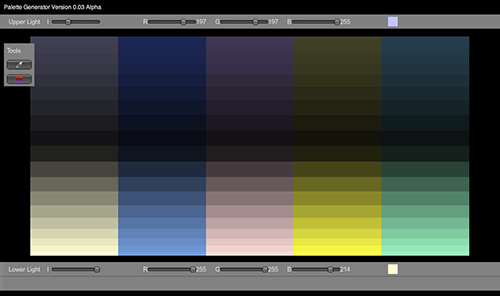Recent & Current Projects
This is a selection of projects that I am currently involved with or have been involved in recently. The projects are listed to the right. Please click on one to read more about it.
Online Colour Tool for Digital Painters

The Online Colour Tool for Digital Painters is a prototype application designed to help novice digital painters build colour palettes. The tool allows the user to input colour values and then vary the properties of lighting to see how it affects the surfaces reflected hue, tone and saturation. Finally, the user can build a palette and output it as an Adobe Swatch Exchange (ASE) file that can be used in Photoshop or Illustrator.
Try the application
To view and try the application, you'll need to have the Unity Web Player Plugin installed. You can find the application here.
Rationale
I learned to create colour imagery with paint. I dabbled in the art of subtractive colour mixing using acrylics, oils and aerosol paints (yes spray paint can be mixed, you need to stick one can in the freezer to lower the pressure and a special straw to permit the paint to flow between cans). Mostly, I learned through experimentation but I also read several books on the topic and exchanged notes with other painters. Over time I developed a little recipe book of colour.
Many of the students I teach today have little experience creating non-photographic colour imagery, and of those that do many report that they have little to no experience mixing colours using subtractive methods. They create all their coursework using digital tools where additive colour is the native language. However, I have noticed that many instructors - including myself - still teach students how to build a palette using the language of subtractive colour and its associated methodologies. Why teach people who will be working largely in digital (additive colour) spaces and who have little prior experience using subtractive colour mixing methods how to mix colour subtractive-ly?
This tool is part of my strategy to teach students to mix colour using additive methods and also to help them better understand how emitted light interacts with coloured surfaces to produce the final colours we see (it does not take into account perceptual effects).
Online Transesophageal Echocardiography Simulation
Collaborators
- Annette Vegas
- Gordon Tait
Description
Two-dimensional transesophageal echocardiography (TEE) is an imaging tool used to visualize the human heart in real-time. It involves the placement of an ultrasound probe at the tip of a very long flexible tube down the patient's esophagus and directly posterior to the patients heart. It is becoming a standard imaging tool during cardiac surgery as well as an important diagnostic tool in cardiology and in intensive care. Increasing use of TEE has led to expansion in the demand for training.
TEE training generally involves classroom and textbook-based instruction followed by "hands-on" learning. Often, TEE novices are thrust from theory to real practice very quickly. Initial experiences performing an actual TEE exam can be challenging for the learner because they must simultaneously deal with temporal limitations, as well as spatial and haptic aspects of the procedure*.
While TEE is a relatively low risk procedure, risks do exist. We perceive that trainees are at higher risk of making potential errors that could harm the patient because they trying to manage so many aspects of a new skill simultaneously. As such, we theorize that any training regime that could reduce the complexity of the task for the learner during initial real TEE use should result in better performance and reduced risk for the patient.
Today, many TEE instruction programs are working with mannequin-based simulation systems. These simulations permit learners to explore both spatial and haptic aspects of TEE in a safe risk-free environment. The quality of several of these tools is excellent. However, they are relatively expensive to acquire and can only be used by a single learner at a time.
We propose - and are developing - an online TEE trainer that will serve as an intermediate educational tool. The tool will permit students to practice their spatial skills, find standard views used in real practice and all in a safe risk free environment where time limitations are only their own. We suggest that this tool should be used in the period between the classroom and the mannequin or real patient. The tool will be accessible to anyone in the world with a desktop computer, and a modern Web browser with the Unity Web Player Plugin installed.
To see examples of other online TEE instruction work I have been involved with, please visit the Toronto General Hospital Department of Anaesthesia and Pain Management VIRTUAL TEE website.
*Temporal challenges - limited time can be spent performing the exam on a live patient. Spatial challenge - understanding the location of the two-dimensional plane in the three-dimensional structure of the heart. Haptic - learning how to move the probe as well as learn the function of the various buttons and dials.